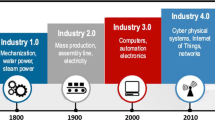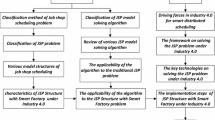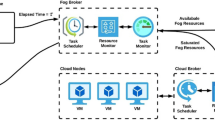Abstract
Unmarked siphons in a Petri net modelling concurrent systems such as those in cloud computing induce deadlocks. The number of siphons grows exponentially with the size of a net. This problem can be relieved by computing compound (or strongly dependent) siphons based on basic siphons. A basic (resp. compound) siphon can be synthesized from an elementary (resp. compound called alternating) resource circuit. It however cannot be extended to cases where two elementary circuits intersect at a directed path rather than a single place (i.e., corresponding to a weakly dependent siphon). This paper develops a uniform formula not only for both cases but also valid for the complementary set of siphon and characteristic vectors. We further propose to generalize it to a compound siphon consisting of \(n\) basic siphons. This helps simplify the computation and the computer implementation to shorten the program size. Also, the formula is easier to be memorized without consulting the references due to the same underlying physics.





Similar content being viewed by others
References
Basile, F., Chiacchio, P., Vittorini, V., & Mazzocca, N. (2004). Modeling and logic controller specification of flexible manufacturing systems using behavioral traces and Petri net building blocks. Journal of Intelligent Manufacturing, 15, 351–371.
Chao, D. Y. (2006). Computation of elementary siphons in Petri nets for deadlock control. The Computer Journal, 49, 470–479.
Chao, D. Y. (2007). An incremental approach to extract minimal bad siphons. Journal of Information Science and Engineering, 23, 203–214.
Chao, D. Y. (2010a). Improved controllability test for dependent siphons in \(\text{ S }^{3}\text{ PR }\) based on elementary siphons. Asian Journal of Control, 12, 377–391.
Chao, D. Y. (2010b). Conservative control policy for weakly dependent siphons in \(\text{ S }^{3}\text{ PR }\) based on elementary siphons. IET Control Theory and Applications, 4, 1298–1302.
Ezpeleta, J., Colom, J. M., & Martinez, J. (1995). A Petri net based deadlock prevention policy for flexible manufacturing systems. IEEE Transactions on Robotics and Automation, 11, 173–184.
Ferrarini, L., Piroddi, L., & Allegri, S. (1999). A comparative performance analysis of deadlock avoidance control algorithms for FMS. Journal of Intelligent Manufacturing, 10, 569–585. doi:10.1023/A:1008964822278.
Hu, H., & Li, Z. W. (2009). Liveness enforcing supervision in video streaming systems using siphons. Journal of Information Science and Engineering, 25(6), 1863–1884.
Hu, H., & Li, Z. W. (2010). Synthesis of liveness enforcing supervisor for automated manufacturing systems. Journal of Intelligent Manufacturing, 21, 555–567.
Hu, H., Zhou, M. C., & Li, Z. W. (2011a). Supervisor design to enforce production ratio and absence of deadlock in automated manufacturing systems. IEEE Transactions on Systems, Man, and Cybernetics, Part A: Systems and Humans, 41, 201–212.
Hu, H., Zhou, M. C., & Li, Z. W. (2011b). Supervisor optimization for deadlock resolution in automated manufacturing systems with Petri nets. IEEE Transactions on Automation Science and Engineering, 8, 794–804.
Hu, H., Zhou, M. C., & Li, Z. W. (2012). Liveness and ratio-enforcing supervision of automated manufacturing systems using Petri nets. IEEE Transactions on Systems, Man, and Cybernetics, Part A: Systems and Humans, 42, 392–403.
Huang, Y. S., & Pan, Y. L. (2010). Enhancement of an efficient liveness-enforcing supervisor for flexible manufacture systems. The International Journal of Advanced Manufacturing Technology, 48, 725–737.
Huang, Y. S., & Pan, Y. L. (2011). An improved maximally permissive deadlock prevention policy based on the theory of regions and reduction approach. IET Control Theory and Applications, 5, 1069–1078.
Huang, Y. S., Pan, Y. L., & Zhou, M. C. (2012). Computationally improved optimal deadlock control policy for flexible manufacturing systems. IEEE Transactions on Systems, Man, and Cybernetics Part A: Systems and Humans, 42, 404–415.
Iordache, M. V., Moody, J. O., & Antsaklis, P. J. (2001). A method for the synthesis liveness enforcing supervisors in Petri nets. Proceedings of the American Control Conference, 6, 4943–4948.
Jeng, M. D., Lin, C. S., & Huang, Y. S. (1999). Petri net dynamics-based scheduling of flexible manufacturing systems with assembly. Journal of Intelligent Manufacturing, 10, 541–555. doi:10.1023/A:1008960721370.
Li, S. Y., An, A. M., Wang, Y., Wang, G., Hou, C. Q., & Cai, Y. (2012). Design of liveness-enforcing supervisors with simpler structures for deadlock-free operations in flexible manufacturing systems using necessary siphons. Journal of Intelligent Manufacturing. doi:10.1007/s10845-012-0647-4.
Li, Z. W., & Zhou, M. C. (2004). Elementary siphons of Petri nets and their application to deadlock prevention in flexible manufacturing systems. IEEE Transactions on Systems, Man, and Cybernetics, Part A: Systems and Humans, 34, 38–51.
Li, Z. W., & Zhou, M. C. (2006). Clarifications on the definitions of elementary siphons in Petri nets. IEEE Transactions on Systems, Man, and Cybernetics, Part A: Systems and Humans, 36, 1227–1229.
Li, Z. W., & Zhou, M. C. (2008). Control of elementary and dependent siphons in Petri nets and their application. IEEE Transactions on Systems, Man, and Cybernetics, Part A: Systems and Humans, 38, 133–148.
Liu, G. J., Jiang, C. J., & Zhou, M. C. (2011a). Improved sufficient condition for the controllability of dependent siphons in system of simple sequential processes with resources. IET Control Theory and Application, 5, 1059–1068.
Liu, G. J., Jiang, C. J., & Zhou, M. C. (2011b). Improved condition for controllability of strongly dependent strict minimal siphons in Petri nets. In Proceedings of the 8th IEEE international conference on networking, sensing and, control, pp. 359–364.
Murata, T. (1989). Petri nets: properties, analysis and application. Proceedings of the IEEE, 77, 541–580.
Pan, Y. L., Huang, Y. S., Jeng, M. D., & Chung, S. L. (2013). Enhancement of an efficient control policy for FMSs using the theory of regions and selective siphons method. The International Journal of Advanced Manufacturing Technology (In press). (DOI:10.1007/s00170-012-4460-1).
Pla, A., Gay, P., Meléndez, J., & López, B. (2012). Petri net-based process monitoring: A workflow management system for process modelling and monitoring. Journal of Intelligent Manufacturing. doi:.10.1023/A:1012292102123.
Uzam, M., & Zhou, M. C. (2006). An improved iterative synthesis approach for liveness enforcing supervisors of flexible manufacturing systems. International Journal of Production Research, 44, 1987–2030.
Uzam, M., Li, Z. W., & Zhou, M. C. (2007). Identification and elimination of redundant control places in Petri net based liveness enforcing supervisors of FMS. The International Journal of Advanced Manufacturing Technology, 35, 150–168.
Wang, S. G., Wang, C. Y., Zhou, M. C., & Li, Z. W. (2012). A method to compute strict minimal siphons in a class of Petri nets based on loop resource subsets. IEEE Transactions on Systems, Man, and Cybernetics, Part A: Systems and Humans, 42, 226–237.
Xiong, P. C., Fan, Y., & Zhou, M. C. (2010). A Petri net approach to analysis and composition of web services. IEEE Transactions on Systems, Man, and Cybernetics, Part A: Systems and Humans, 40, 376–387.
Yamalidou, K., Moody, J., Lemmon, M., & Antsaklis, P. (1996). Feedback control of Petri nets based on place invariants. Automatica, 32, 15–28.
Zimmermann, A., Rodriguez, D., & Silva, M. (2001). A two phase optimization method for Petri net models of manufacturing systems. Journal of Intelligent Manufacturing, 12, 409–420.
Acknowledgments
This work was partially supported by the National Science Council of Taiwan, R.O.C. under Grant NSC 100-2221-E-004-001 and NSC 101-2221-E-013-001.
Author information
Authors and Affiliations
Corresponding author
Rights and permissions
About this article
Cite this article
Chao, D.Y., Pan, YL. Uniform formulas for compound siphons, complementary siphons and characteristic vectors in deadlock prevention of flexible manufacturing systems. J Intell Manuf 26, 13–23 (2015). https://doi.org/10.1007/s10845-013-0757-7
Received:
Accepted:
Published:
Issue Date:
DOI: https://doi.org/10.1007/s10845-013-0757-7




